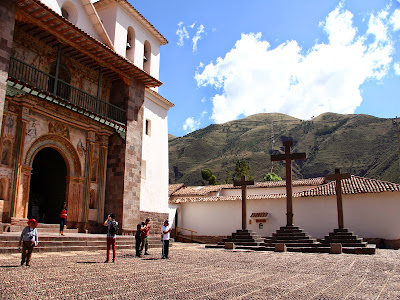Home now after two days of travel and getting back into an ordinary routine. I already miss Peru and the colorful people of the rural areas.
In the big cities like Lima the people live a life much like anywhere else in the modern world. But, not far away in the smaller centres and rural areas time has stood still. Everywhere the lifestyle is much unchanged from the 17th century.
A nun returns from the Cathedral in Cusco.
Local musician playing a traditional instrument in an alley in Cusco. A native Incan artisan walking down into the centre in Cusco to the markets.
The elders welcome worshippers outside the church in Pisac.
The colorful, traditional costumes that they wear in their everyday lives. The traditional lifestyle of family, church and work.
.Small terraced farms where they grow their crops without the aid of modern equipment, not a tractor in sight. The markets where they trade and barter their produce.



The woman dressed in their traditional garb spinning wool and weaving beautiful patterns and textures into the soft woolen fabrics. Beautiful handmade sweaters, table cloths, runners, blankets.




 Children playing in the yards as the adults work nearby, dressed in colorful woolen sweaters, hats and ponchos.
Children playing in the yards as the adults work nearby, dressed in colorful woolen sweaters, hats and ponchos.
Ancient stone walls around small homes. Llamas, alpacas, the occasional goat or sheep or donkey. Guinea pigs in coops much like we have chicken coops, raised for food.




But most notably, the smiles, warm, welcoming, open, genuine. They are happy. They sing as they work. They are, more importantly, content. Content with this simple life. Happy to have their families around them, to teach their children the same skills and traditions that have served them well. As our guide, Elvira, said. Our people may be poor but they are never hungry or miserable.


The life expectancy is only 62 for men and 67 for women. This is because they do not have access to modern medicine, they can not afford it. They rely on the local shaman and traditional herbal remedies. Women do not rely on medical doctors for childbirth, they rely on the shamans as midwives with the family around. The hospitals have no heat and relatives are not allowed, no wonder they prefer to have their babies at home.
They live on the land up in the mountains, miles from the villages far below. Young children attend elementary school near their homes, but at 11 or 12 they must travel to the schools in the distant towns. No transportation is provided, they walk to school and back, sometimes several hours a day.
 In larger centres like Cusco there is a mix, evidence of the old alongside the modern. Most people work in the tourist industry. They are modern in their dress and everyday life, but still tied to their roots and their heritage. Most come from the nearby rural areas and remain close to their families and traditions. But everywhere you see evidence of the traditional Peru. Women and children dressed in colorful Peruvian costumes with llamas, alpacas or baby goats, posing for tourists on the steps of the basilicas for a couple of coins. Women dressed in their colorful skirts, hats perched on their heads, a colorful bundle on their back where they carry their wares to the markets. At every courtyard or plaza they spread their colorful blankets on the ancient stones and spread out their wares... colorful fabrics, sweaters, mittens, socks.
In larger centres like Cusco there is a mix, evidence of the old alongside the modern. Most people work in the tourist industry. They are modern in their dress and everyday life, but still tied to their roots and their heritage. Most come from the nearby rural areas and remain close to their families and traditions. But everywhere you see evidence of the traditional Peru. Women and children dressed in colorful Peruvian costumes with llamas, alpacas or baby goats, posing for tourists on the steps of the basilicas for a couple of coins. Women dressed in their colorful skirts, hats perched on their heads, a colorful bundle on their back where they carry their wares to the markets. At every courtyard or plaza they spread their colorful blankets on the ancient stones and spread out their wares... colorful fabrics, sweaters, mittens, socks. 


I envy this simple life, this pure life. It is something we have lost along the way. It strikes me that the more we have, the more we have lost - the roots, the pride in our traditions and cultures. I do not see entitlement. I don not see self-centred princesses.
 |
| Add caption |






























